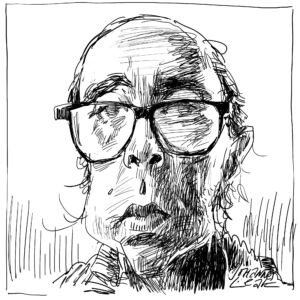It’s time Brits got down with the Lingo
Gaston Dorren’s fascinating book is a must-read for us chauvinistic monoglots.

Want unlimited, ad-free access? Become a spiked supporter.
The British are a people obsessed with words and language. Witness our devotion to the crossword puzzle and Countdown, jokes involving wordplay and puns, or our weakness for inveighing against split infinitives and misplaced apostrophes. As the Irish comedian David O’Doherty once quipped, the British only went to war with Germany because we once saw Hitler spell it ‘Nazi’s’.
Yet we only seem enamoured with our own language, English. We are notorious monoglots, a situation that has been worsened by the global triumph of (American) English in the past hundred years or so. Either through imperial-minded triumphalist ignorance, or a fear of making fools of ourselves by making mistakes, the British have traditionally been reluctant to speak native languages when abroad – especially in Europe.
Gaston Dorren’s Lingo: A Language Spotter’s Guide seeks to remedy this, a bit. He wants to broaden our minds with this breezy guide in 60 histories of the multiplicity of tongues spoken on the continent, elucidating on their bewildering and beguiling nuances, intricacies, and, to our eyes, oddities.
We learn here that French, perhaps the only foreign language most of us have attempted abroad – or haven’t, for fear of sounding like ‘Allo ‘Allo‘s Officer Crabtree – has a ‘mother complex’. By this, the author means, it has sought to be the language that spawned it, Latin. During the Renaissance, in an attempt to appear more ‘classical’, French imported many Latin words to replace some barbarian Frankish ones, so that for instance, ‘sur’ (‘sour’) came to be supplanted by ‘acide’, and ‘maint’ (‘many’) by ‘beaucoup’.
Spellings were likewise altered to reflect not how French words were spoken, but to accord with their Latin etymology. A redundant ‘h’ was affixed to ‘homme’ (to accord with ‘homo’) and ‘temps’ was changed so that it looked like ‘tempus’ – even though it still doesn’t sound like it. But then again, late medieval English scholars likewise inserted a silent ‘b’ into ‘dette’ and redundant ‘c’ into ‘sisours’ on the same spurious appeal to the antiquity. French isn’t the only European language with a ‘mother fixation’.
Still, Lingo is abundant with such rich fare. We learn that in Irish Gaelic every consonant can be pronounced two different ways, and that the meaning of many words is dependent on this. German boasts the verb ‘gönnen’, meaning ‘to be gladdened by someone else’s good fortune’, which it’s a nice rejoinder to those who smugly and unfunnily pronounce that only a people so beastly as the Hun could have invented the word ‘schadenfreude’.
Then there is a fascinating account of the campaign in Sweden to democratise its language in past decades. This began in the 1960s, first with the diffusion of the informal, first-person singular form of you – ‘du’ (comparable to the French ‘tu’) – as a means to address all people, irrespective of social rank or age. More recently, there’s been the comparably successful campaign to promote a gender-neutral substitute for ‘he’ (‘han’) and ‘she’ (‘hon’), in the form ‘hen’.
The latter initiative was directly inspired by Sweden’s neighbours, the Finns, who had already devised a neologism for ‘s/he’, or ‘ze’, or whatever charmless English equivalent takes your fancy. It was a suitably logical and progressive move from a language that is the most phonetic in Europe. Yet, don’t be fooled into assuming Finnish is easy or rational. It manages to have no less than 15 noun cases, yet it still has no verb for ‘to have’. Nordic countries continue to intrigue here. The ‘standard’ Norwegian you might learn on a ‘teach yourself’ CD is not the Norwegian spoken in the west of the country, the land with two (and a half) mother tongues.
Yet, Norwegians, Swedes and Danes can all still generally understand each other. So, too, can the Serbs and the Croats (as a boy holidaying on the Dalmation coast on 1984, I learnt how to count to 10 in what was called ‘Serbo-Croat’). All languages are classified separately for reasons of national chauvinism as much as linguistic felicity. Linguistically speaking, Dutch can be considered a German dialect, and it’s closer to Standard German than many orthodox German dialects.
Dorren regularly returns to issues of mutual intelligibility, shades of comprehension and the role regionalism and nationalism play in determining what is deemed a ‘proper’ language and what is ‘slang’ or ‘dialect’. And as any student of Italian will have grasped, the ‘standard’ form of a language is constructed to serve as an acceptable version for all: modern Italian is essentially Tuscan writ large.
English was merely standardised in a slower time period than Italian. Chaucer’s English would have been met with near incomprehension outside Kent. Only in 1982 were the five variants of Romansh standardised, yet still there are those who continue to speak its dialect. As Dorren sagely puts it: ‘Dialects came first, and tend to be the root of any standard language, which is always an artefact.’
The author, who is Dutch, expounds at length at the efforts by the speakers of West Frisian in the northern part of his country to have their vernacular recognised as a language – not a dialect – by the Dutch government. He does, however, sadly, miss a trick here. Frisian is actually closer to English than it is to Dutch, and it’s the closest living, officially recognised language to ours. ‘Goeie moarn’ a Frisian would greet you, before asking ‘Wat is jo namme?’. In that part of Holland you spread bûter on your brea.
There are arenas of mutual intelligibility untainted by international or regional matters. Although Hungarian and Finnish have drifted apart beyond mutual comprehension, their common Finno-Ugric ancestry can be observed in the Finnish sentence ‘Elävä kala ui veden alla’, which by turn in Hungarian is ‘Eleven hal úszkál a víz alatt’ (‘the living fish swims underwater’). The author writes that Lithuanian is the most fossilised European language, but yet again, he could have mentioned that, in being so, Sanskrit speakers can understand much Lithuanian.
No contemporary book about languages would be complete without sections on: a) why Esperanto failed; b) how the world’s minority languages are mortally imperilled; and c) why English won’t be the world’s language forever, and will probably be replaced by Chinese. Lingo obliges on all counts, but not as one would expect.
While received wisdom has it that Esperanto didn’t succeed despite being easy to learn, Dorren maintains that its inherent and unnecessary difficulty was actually instrumental to its failed promise. Its case system was alien to everyone north, west and south of Germany. It had verbs agreeing with nouns, which further alienated English-speakers, while its ‘h’ sound did likewise for Latinates. The want or need or reason to learn Esperanto may have been fundamental to its still-birth, but these factors, and not to mention its sheer ugliness, also played a part.
On the second theme, Dorren issues the heresy that ‘small languages are not necessarily doomed’ and that ‘even death needn’t be the last word’, citing Cornish, the last native speaker of which died in 1777. Thanks to the enthusiasm of grass-roots campaigners, and not least the medium of internet, Cornish has been resurrected, now understood by thousands and used daily by hundreds. Irish Gaelic has been comparably rescued by television. Another ‘ex-language’, Manx, is now taught in schools.
As for English, he repeats the common prognostication that it will be one day supplanted by the equally messy and illogical Chinese. I don’t believe this. Both languages may have achieved dominance owing more to economic imperialism than linguistic economy and clarity, but English did so before the age of worldwide literacy and global information exchange through the medium of the word. The world isn’t going to learn Chinese script, especially as the country with a now flabby middle-class hasn’t turned out to be the economic super-giant we were told it would be.
Lingo is ambitious in its scatter-gun approach, and the results can be bitty, even overwhelming. Yet the author has drunk deeply from the Indo-European linguistic font, even including two languages that don’t belong to that family: Basque and sign-languages. As Dorren forcibly demonstrates, there is so much more to speaking foreign than ‘où est la gare?’.
Patrick West is a writer and journalist. Visit his blog here.
Lingo: A Language Spotter’s Guide to Europe, by Gaston Dorren, is published by Profile Books. (Buy this book from Amazon(UK).)
You’ve read 3 free articles this month.
Support spiked and get unlimited access.
Help us hit our 1% target
spiked is funded by readers like you. It’s your generosity that keeps us fearless and independent.
Only 0.1% of our regular readers currently support spiked. If just 1% gave, we could grow our team – and step up the fight for free speech and democracy right when it matters most.
Join today from £5/month (£50/year) and get unlimited, ad-free access, bonus content, exclusive events and more – all while helping to keep spiked saying the unsayable.
Monthly support makes the biggest difference. Thank you.










Comments
Want to join the conversation?
Only spiked supporters and patrons, who donate regularly to us, can comment on our articles.